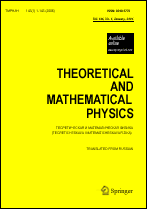|
This article is cited in 29 scientific papers (total in 29 papers)
Solutions of the three-dimensional sine-Gordon equation
E. L. Aero, A. N. Bulygin, Yu. V. Pavlov
Institute of Problems of Mechanical Engineering, Russian Academy of Sciences
Abstract:
We obtain exact solutions $U(x,y,z,t)$ of the three-dimensional sine-Gordon equation in a form that Lamb previously proposed for integrating the two-dimensional sine-Gordon equation. The three-dimensional solutions depend on arbitrary functions $F(\alpha)$ and $\Phi(\alpha,\beta)$, whose arguments are some functions $\alpha(x,y,z,t)$ and $\beta(x,y,z,t)$. The ansatzes must satisfy certain equations. These are an algebraic system of equations in the case of one ansatz. In the case of two ansatzes, the system of algebraic equations is supplemented by first-order ordinary differential equations. The resulting solutions $U(x,y,z,t)$ have an important property, namely, the superposition principle holds for the function $\operatorname{tan}(U/4)$. The suggested approach can be used to solve the generalized sine-Gordon equation, which, in contrast to the classical equation, additionally involves first-order partial derivatives with respect to the variables $x$, $y$, $z$, and $t$, and also to integrate the sinh-Gordon equation. This approach admits a natural generalization to the case of integration of the abovementioned types of equations in a space with any number of dimensions.
Keywords:
sine-Gordon equation, wave equation, Hamilton–Jacobi equation, superposition principle.
Received: 23.05.2008
Citation:
E. L. Aero, A. N. Bulygin, Yu. V. Pavlov, “Solutions of the three-dimensional sine-Gordon equation”, TMF, 158:3 (2009), 370–377; Theoret. and Math. Phys., 158:3 (2009), 313–319
Linking options:
https://www.mathnet.ru/eng/tmf6320https://doi.org/10.4213/tmf6320 https://www.mathnet.ru/eng/tmf/v158/i3/p370
|


|




 Contact us:
Contact us: Terms of Use
Terms of Use
 Registration to the website
Registration to the website Logotypes
Logotypes








 Citation in format
Citation in format 
